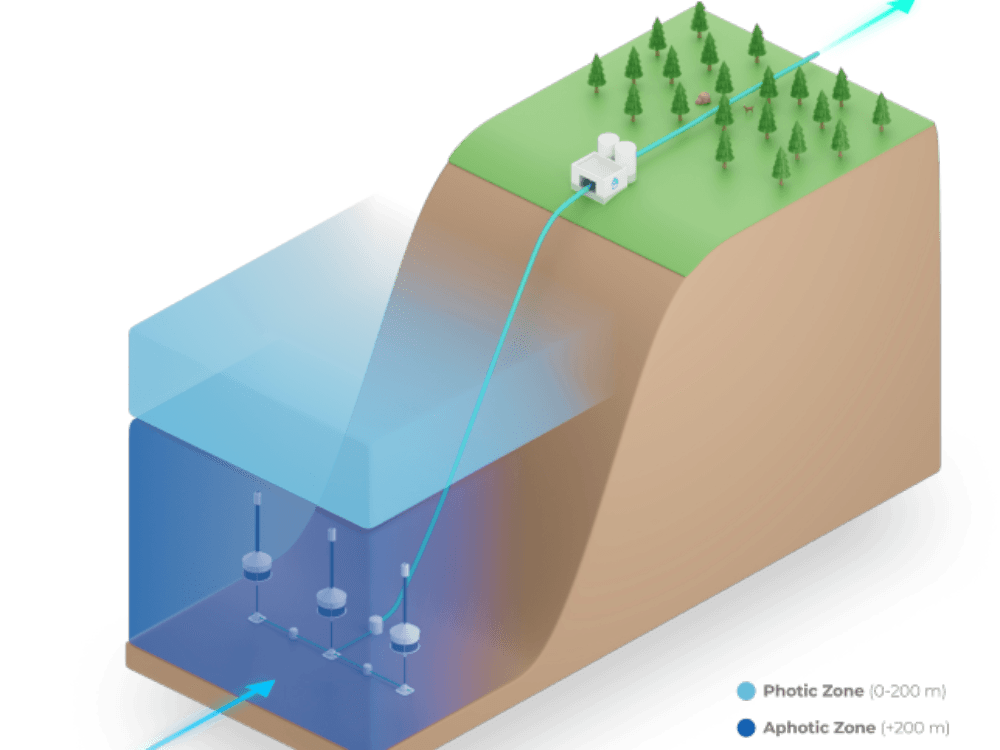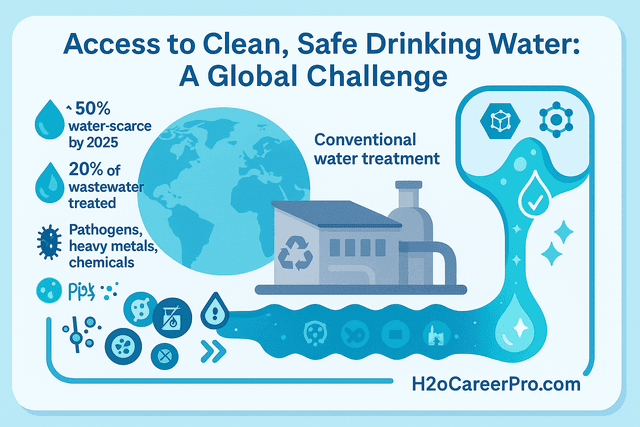OceanWell represents a paradigm shift in desalination technology, pioneering subsea desalination systems that operate directly on the ocean floor to produce fresh water with unprecedented energy efficiency and minimal environmental impact. This revolutionary approach addresses the critical challenges facing conventional land-based desalination plants while opening new possibilities for sustainable water supply in coastal communities worldwide. This comprehensive analysis explores OceanWell's innovative technology, operational advantages, environmental benefits, and potential impact on the future of seawater desalination.
The Innovation Behind OceanWell Technology
OceanWell's subsea desalination technology fundamentally reimagines how we approach seawater treatment by moving the entire process underwater. This approach leverages the natural pressure of the deep ocean to drive the reverse osmosis process, eliminating the need for high-pressure pumps that typically consume 60-70% of a desalination plant's energy requirements.
Technical Innovation: By deploying desalination modules at depths of 300-600 meters, OceanWell utilizes 30-60 bar of natural hydrostatic pressure to drive the RO process. This eliminates the largest energy consumer in conventional desalination plants and enables operation with renewable energy sources like offshore wind.
Subsea System Architecture and Components
Modular Desalination Pods
OceanWell's system consists of modular underwater pods that house the complete desalination process. Each pod is designed for autonomous operation in the harsh marine environment while providing easy access for maintenance and monitoring.
- Pressure Vessel Design: Robust titanium and high-grade steel construction rated for deep-sea pressures and corrosive seawater environment
- Membrane Configuration: Advanced spiral-wound RO membranes optimized for seawater treatment under high-pressure conditions
- Pretreatment Systems: Integrated filtration and conditioning systems to protect RO membranes from fouling and scaling
- Energy Recovery: Sophisticated energy recovery devices to maximize efficiency of the high-pressure process
Power and Control Systems
The subsea environment presents unique challenges for power delivery and system control. OceanWell has developed innovative solutions for reliable operation in this demanding environment.
- Subsea Power Distribution: High-voltage DC power transmission from surface or shore
- Variable Frequency Drives: Precise control of pumping systems for optimal efficiency
- Remote Monitoring: Real-time telemetry and control via fiber optic communication
- Autonomous Operation: Advanced control algorithms for unmanned operation periods
Product Water Delivery Systems
Delivering high-quality fresh water from the seabed to shore requires sophisticated pipeline and pumping systems designed for long-term reliability and efficiency.
Delivery Innovation: OceanWell employs low-pressure product water pumps and flexible pipeline systems to transport fresh water to shore. The reduced pressure requirements (compared to high-pressure RO feed systems) significantly lower energy consumption for water transport over distances up to 15 km.
Energy Efficiency and Performance Advantages
Energy Consumption Analysis
OceanWell's subsea approach achieves remarkable energy efficiency compared to conventional land-based desalination plants. The elimination of high-pressure pumping represents a fundamental advancement in desalination technology.
Energy Comparison (kWh/m³):
- Conventional SWRO: 3.5-4.5 kWh/m³ (including intake, pretreatment, and distribution)
- Energy-Efficient SWRO: 2.8-3.2 kWh/m³ (with advanced energy recovery)
- OceanWell Subsea: 2.0-2.5 kWh/m³ (40% energy reduction)
- Energy Breakdown: Primarily low-pressure pumping and controls vs. high-pressure RO feed
Renewable Energy Integration
The reduced and more flexible energy requirements of OceanWell systems make them ideal candidates for integration with renewable energy sources, particularly offshore wind power.
Renewable Integration: OceanWell systems can operate effectively with variable power input, making them compatible with wind and solar energy sources. Energy storage systems can be integrated to provide continuous operation during low renewable generation periods. This capability opens opportunities for truly sustainable desalination operations.
Water Quality and Recovery Rates
Subsea operation provides several advantages for water quality and system performance, including stable operating conditions and enhanced membrane performance.
- Product Water Quality: Consistently meets or exceeds WHO drinking water standards
- Recovery Rates: 35-45% typical, comparable to land-based systems
- Temperature Stability: Consistent deep-water temperatures optimize membrane performance
- Reduced Biofouling: Deep-sea environment minimizes biological growth on system components
Environmental Benefits and Sustainability
Brine Discharge and Ocean Impact
One of the most significant environmental advantages of OceanWell's technology is its approach to brine discharge. By operating at depth and utilizing deep-water currents, the system minimizes environmental impact on coastal ecosystems.
- Deep-Water Discharge: Brine released at depth where natural mixing is more effective
- No Coastal Impact: Eliminates brine discharge near sensitive coastal environments
- Enhanced Dilution: Ocean currents provide rapid mixing and dilution of concentrate
- Marine Life Protection: Avoids intake and discharge impacts on coastal marine ecosystems
Carbon Footprint Reduction
The energy efficiency gains achieved by OceanWell technology translate directly into significant carbon footprint reductions, particularly when combined with renewable energy sources.
Climate Impact: A 40% reduction in energy consumption translates to approximately 1.5-2.0 kg CO₂ reduction per cubic meter of water produced compared to conventional desalination. For a 100 MGD facility, this represents annual CO₂ savings of 200,000-300,000 tons, equivalent to removing 50,000 cars from the road.
Land Use and Visual Impact
By moving desalination operations offshore, OceanWell eliminates the land use requirements and visual impacts associated with large desalination facilities, preserving valuable coastal land for other uses.
- Zero Land Footprint: Entire treatment facility located underwater
- Preserved Coastlines: No visual impact on coastal landscapes and communities
- Reduced Infrastructure: Minimal onshore facilities required
- Multi-Use Compatibility: Compatible with other ocean activities and conservation areas
Technical Challenges and Solutions
Deep-Sea Operating Environment
Operating sophisticated desalination equipment in the challenging deep-sea environment requires innovative engineering solutions to address pressure, corrosion, and accessibility challenges.
- Pressure Management: System components must withstand external pressures up to 60 bar
- Corrosion Resistance: Materials selection and protective coatings for long-term durability
- Remote Diagnostics: Advanced monitoring systems to detect and diagnose issues remotely
- Maintenance Protocols: Specialized ROV and diving procedures for subsea maintenance
Membrane Performance and Longevity
Ensuring optimal membrane performance in the subsea environment requires careful attention to pretreatment, operating conditions, and membrane selection.
Membrane Optimization: OceanWell utilizes specially selected membranes optimized for high-pressure, low-temperature operation. Pretreatment systems include advanced filtration and chemical conditioning to minimize fouling. Expected membrane life is 3-5 years, comparable to land-based systems despite the challenging environment.
System Reliability and Redundancy
Reliability is critical for subsea systems where access is limited and expensive. OceanWell incorporates multiple levels of redundancy and fail-safe designs to ensure continuous operation.
- Modular Redundancy: Multiple independent pods provide backup capacity
- Component Backup: Critical components have built-in redundancy
- Predictive Maintenance: AI-based systems predict and prevent equipment failures
- Emergency Protocols: Automated shutdown and recovery procedures
Economic Analysis and Market Applications
Capital and Operating Cost Comparison
While OceanWell systems require specialized subsea equipment, the elimination of high-pressure pumping systems and reduced onshore infrastructure can result in competitive total project costs.
Cost Analysis (per m³/day capacity):
- Conventional SWRO: $1,200-1,800 CAPEX, $0.45-0.65 OPEX
- OceanWell Subsea: $1,400-2,000 CAPEX, $0.35-0.50 OPEX
- Break-even Period: 8-12 years due to reduced energy and maintenance costs
- Lifecycle Benefits: 20-30% lower total cost of ownership over 25 years
Target Markets and Applications
OceanWell technology is particularly well-suited for specific market segments where its unique advantages provide the greatest value proposition.
- Island Communities: Remote islands with limited land and high energy costs
- Coastal Megacities: Dense urban areas where land is scarce and expensive
- Industrial Applications: Offshore platforms and marine industries requiring fresh water
- Water-Stressed Regions: Areas with environmental constraints on conventional desalination
Financing and Investment Considerations
The innovative nature of OceanWell technology requires specialized financing approaches that account for both the technological risks and long-term operational benefits.
Investment Strategy: Projects typically require a combination of development capital, technology licensing, and long-term water purchase agreements. Green financing and carbon credit opportunities can provide additional revenue streams. The 25-year operational life and predictable performance metrics make these projects attractive for infrastructure investment funds.
Case Studies and Deployment Examples
Pilot Project Performance
OceanWell has conducted several pilot projects that demonstrate the viability and performance of subsea desalination technology under real-world operating conditions.
- Caribbean Deployment: 1 MGD pilot system operating at 400m depth
- Performance Results: 2.2 kWh/m³ energy consumption, 99.5% availability
- Water Quality: Consistent TDS <100 mg/L, all regulatory standards exceeded
- Environmental Monitoring: No detectable impact on local marine ecosystems
Commercial Scale Development
Building on pilot project success, OceanWell is developing commercial-scale installations that will demonstrate the technology's ability to provide municipal water supplies.
Scale-Up Strategy: Commercial projects range from 10-100 MGD capacity using multiple modular pods connected to shared infrastructure. This approach provides flexibility for phased development and operational redundancy while minimizing project risk through proven component technology.
Future Technology Development
Next-Generation Innovations
OceanWell continues to advance subsea desalination technology through ongoing research and development programs focused on further efficiency improvements and expanded applications.
- Advanced Membranes: Developing high-pressure membranes optimized for subsea operation
- Energy Integration: Direct connection to offshore wind turbines for renewable power
- AI Optimization: Machine learning for predictive maintenance and performance optimization
- Modular Expansion: Standardized components for rapid deployment and scaling
Industry Impact and Standardization
As subsea desalination technology matures, industry standards and best practices are being developed to ensure safe and effective deployment across different applications and environments.
Standards Development: Industry organizations are developing standards for subsea desalination system design, installation, operation, and maintenance. These standards will facilitate broader adoption and ensure consistent safety and performance across the industry. Regulatory frameworks are also evolving to address the unique aspects of offshore desalination operations.
Frequently Asked Questions
Q: How does the water quality from OceanWell systems compare to conventional desalination?
A: OceanWell systems produce water quality that meets or exceeds all drinking water standards, comparable to conventional desalination plants. The stable deep-sea operating environment and consistent membrane performance actually provide more reliable water quality than land-based systems that must deal with variable intake conditions.
Q: What happens if the subsea system requires maintenance or repair?
A: OceanWell systems are designed with modular redundancy and remote diagnostics to minimize maintenance requirements. When maintenance is needed, specialized ROV (remotely operated vehicle) systems and certified diving teams can access and service equipment. Critical components are designed for quick replacement using standard subsea intervention techniques.
Q: How does the energy efficiency compare to other advanced desalination technologies?
A: OceanWell achieves 40% energy savings compared to conventional seawater reverse osmosis by eliminating high-pressure pumping requirements. This represents one of the most significant energy efficiency improvements in desalination technology, making it competitive with or superior to other advanced approaches like forward osmosis or membrane distillation.
Q: What are the environmental benefits compared to conventional coastal desalination?
A: OceanWell provides significant environmental advantages including zero land footprint, deep-water brine discharge with better mixing, no coastal ecosystem impacts, and 40% lower carbon footprint due to reduced energy consumption. The technology eliminates many of the environmental concerns associated with conventional coastal desalination facilities.
Explore Next-Generation Desalination Technology
Learn more about how OceanWell and other innovative technologies are revolutionizing seawater desalination. Discover the future of sustainable water supply solutions.

